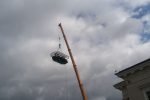The Autonomous Republic of Nakhchivan is located in the southwest corner of the Lower Caucasus. It is a mountainous terrain and stands at 600 to 1000 meters above sea level.
 The Climate of Nakhchivan is mostly continental and dry; it is characterized by cold winters while summer seasons are hot and dry. This landlocked territory of Azerbaijan has a border of 246 km long with Armenia that rings Nakhchivan from the north to the southern border where it connects with the Iranian border that stretches for 204 km from the south towards the northwest, and then Turkey shares a narrow border of 11km wide. The prosperous autonomous Republic of Nakhchivan has a population of 390.000 and its territory is only 5500 square kilometers.
The Climate of Nakhchivan is mostly continental and dry; it is characterized by cold winters while summer seasons are hot and dry. This landlocked territory of Azerbaijan has a border of 246 km long with Armenia that rings Nakhchivan from the north to the southern border where it connects with the Iranian border that stretches for 204 km from the south towards the northwest, and then Turkey shares a narrow border of 11km wide. The prosperous autonomous Republic of Nakhchivan has a population of 390.000 and its territory is only 5500 square kilometers.
Some of the highest peaks in Nakhchivan exceed the 3,000 meters (Ishikhli mountain is 3,552 m), although 1,500-2,500 m are more common. Highland ranges of Zangazur and Daralayaz rise along the boundary of Nakhchivan. The peak of the Zangazur range – Kaputjukh Mountain is 3,904 meters; it is the tallest non-volcanic point of the Trans-Caucasian highlands. The southern foot of the Zangazur range is washed by the Araz River which is over 1.072 km long and stretches in Azerbaijan, Iran, Armenia and Turkey. The Talysh Mountains have a medium height; their highest point is Kyumyurkey with 2,477 meters. The most north-eastern slopes of these mountains are in Azerbaijan. They are divided into three parallel chains by valleys and hollows. The main river bed creates the boundary of Azerbaijan and Iran so the Talysh slopes entirely lie on Iranian territory.
Azerbaijan is situated on the southeastern part of the Caucasus, which stretches for more than 800 km from the Black Sea to the Caspian Sea. Lying at the crossroads of Europe and Asia, the country has a unique geographical position, and retains its significance for world economic and cultural links.
Nakhchivan is one of the smallest regions in the nation of Heydar Aliyev, its founding leader, however it is almost impossible to find a similar place in the world with almost the same territorial size that would contribute as much to human history as this region of Azerbaijan. Azerbaijan has been a very strong country in almost every period of its history, particularly in the XII century. The name ‘Nakhchivan’ derives from Noah-Jahan. It is believed that the name of the city of Nakhchivan is related to Prophet Noah. According to archaeological sources, this area has the traces of the big floods in antiquity that were described in the Koran and the Bible.
More than half of the territory of Azerbaijan is mountainous, to the north is the Greater Caucasus with the highest peak: Bazardyuzy, 4,466 meters (its south-eastern part reaches Azerbaijan), to the southwest is the massive Trans-Caucasian upland extending to Armenia and Georgia, bordered by the Lower Caucasus, and to the south there are the Talysh Mountains. These highly striking territorial surfaces, along with geographical particularities, profoundly determine the diversity and abundances of its unique nature, encompassing the features of the Caucasus and Middle Asia region.
In 1920, due to the Bolshevik transfer of Azerbaijan’s Zangazur province to Armenia, the territory of Nakhchivan was separated from the mainland of Azerbaijan.
Under the rule of the Soviet Union, Nakhchivan had access to a railway that provided a connection with the mainland of Azerbaijan by using a corridor of the former Azeri region of Mehri. After the fall of the Soviet Union, the Armenian Armed Forces attacked Azeri lands and occupied seven more regions and at this time the railway connecting the mainland of Azerbaijan was cut off by Armenia. Since 1991, Nakhchivan does not have any infrastructure connection with the mainland due to the blockade imposed by Armenia. The only way to visit the other regions of Azerbaijan is by plane using the air corridor through Iran and the road on Iranian territory. Every day there are six scheduled flights that travel from Nakhchivan to Baku and in the past there have been direct flights, weekly, to Moscow and Istanbul, Turkey.
Peter Tase is a contributor, freelance journalist and a research scholar of International Affairs, Paraguayan Studies, Middle East Studies and Latin American Affairs, located in the United States. Educated at the University of Wisconsin – Milwaukee and Marquette University Les Aspin Center for Government; Tase is the author of “Simultaneous Dictionary in Five Languages: Guarani, English, Italian, Albanian and Spanish” and “El Dr. FEDERICO FRANCO y Su Mandato Presidencial en la Historia del Paraguay.” He’s a frequent contributor to Foreign Policy News. His personal website is www.petertase.com
Related posts:
Ordubad: an ancient city in the heart of Eurasia By Peter Tase On October 5th, 2014, I had the…
Armenia-Azerbaijan relations: Steps toward peace By James J. Coyle Last week, the presidents of Armenia…
Azerbaijan and Turkmenistan’s bitter exchange in the Caspian. Is Russia involved? Two neighborly nations Azerbaijan and Turkmenistan separated by Caspian Sea…
Clinton’s visit sparks shoot-outs in Caucasus Secretary of State Hillary Clinton is on an eight-day tour…
Azerbaijan foils another anti-Israeli plot Just when everybody thought it was over, Azerbaijan announced an…
Tags: Armenia, Azerbaijan, South Caucasus
In foto: Peter Tase.
www.foreignpolicynews.org
2014.11.04; 20:11











